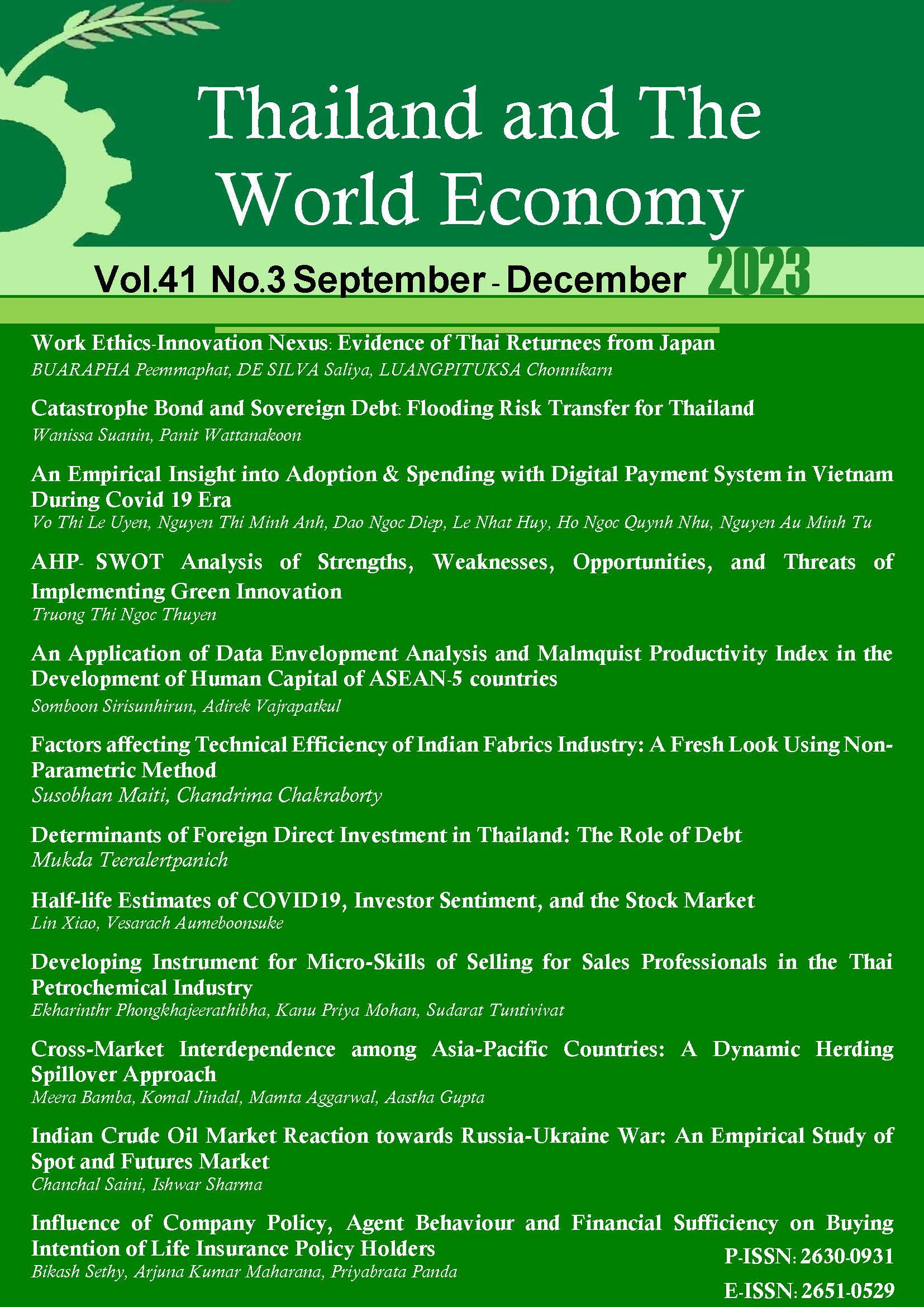Determinants of Foreign Direct Investment in Thailand: The Role of Debts
Keywords:
FDI, Foreign Direct Investment, Debt, ThailandAbstract
This paper investigates the impact of debts, classified by borrowers and sources, on foreign direct investment (FDI) inflows, both aggregate and selected sectors, in Thailand during 1997: Q1 to 2020: Q4. Drawing upon the OLI paradigm and considering the motivations of multinational enterprises (MNEs) in conducting direct investment, the study applies the ARDL approach to examine this relationship in both the short run and the long run. The results showed that increases in total debt adversely affect total FDI inflows both in the short run and the long run. The results of public, private, household, and corporate debt are in line with the outcome of total debt. Interestingly, in the short run, increases in domestic debt helped attract FDI inflows, but in the long run, its undesirable impact became evident. External debt also negatively impacted FDI inflows, but only in the short run. When analyzing key sectors, the impacts of debt on FDI inflows vary. The negative impact of debt on FDI inflows was highest in the manufacture of electrical equipment, followed by the manufacture of computer, electronic, and optical products, while no significant impact was observed in the manufacture of motor vehicles, trailers, and semi-trailers.
References
Abala, D.O. (2014). Foreign direct investment and economic growth: An empirical analysis of Kenyan data. DBA-Africa Management Review, 4(1), 62-83.
Asiedu, E. (2006). Foreign direct investment in Africa: The role of natural resources, market size, government policy, institutions and political instability. World Economy, 29(1), 63-77.
Banga, R. (2003). Impact of government policies and investment agreements on FDI inflows. ICRIER Working papers no. 16. New Delhi: ICRIER.
BOI (2020). รายงานภาวการณ์ลงทุนโดยตรงจากต่างประเทศในประเทศไทย ฉบับรายปี 2563 (มกราคม-ธันวาคม). Retrieved from https://www.boi.go.th/upload/content/2563_6082a4cb538c1.pdf
Changwatchai, P. (2010). The determinants of FDI inflows by industry to ASEAN (Indonesia, Malaysia, Philippines, Thailand, and Vietnam). (Doctoral dissertation, The University of Utah, Salt Lake City, Utah). Retrieved from https://collections.lib.utah.edu/dl_files/7d/58/7d5894fb6cff6e947b1b81452a45d001d45bd441.pdf
Dunning, J. H., & Lundan, S. M. (2008). Multinational enterprises and the global economy. Cheltenham: Edward Elgar Publishing.
Flexner, N. (2000). Foreign direct investment and economic growth in Bolivia, 1990-1998. Economic Policy Division. La Paz, Bolivias: Central Bank of Bolivia Research Paper. Retrieve from https://econwpa.ub.uni-muenchen.de/econ-wp/mac/papers/0309/0309009.pdf
Hill, H. (2019). Managing FDI in a globalizing economy: Asian experiences. London, UK: Palgrave Macmillan.
Jansen, W. J. (2003). What do capital inflows do? Dissecting the transmission mechanism for Thailand, 1980–1996. Journal of Macroeconomics, 25(4), 457-480.
Johanson, J., & Vahlne, J. E. (1977). The internationalization process of the firm—A model of knowledge development and increasing foreign market commitments. Journal of international business studies, 8(1), 23-32.
Jongwanich, J. (2011). Foreign direct investment in emerging Asia: Implications of the international production network. In Hutson, E., Sinkovics, R.R., Berrill, J. (Eds.) Firm-level internationalization, regionalism and globalization (pp. 27-47). London, Palgrave Macmillan.
Khrawish, H., & Siam, W. (2010). Determinants of direct foreign investment: Evidence from Jordan. Business and Economic Horizons, 1(1), 67-75.
Milner, C., Reed, G., & Talerngsri, P. (2004). Foreign direct investment and vertical integration of production by Japanese multinationals in Thailand. Journal of Comparative Economics, 32(4), 805-821.
Mostafa, M. (2020). Foreign direct investment, external debt, and balance of payment: A causality analysis for Bangladesh. Bangladesh Journal of Public Administration, 27(2), 50-69.
NESDC (2021). ภาวะสังคมไทยไตรมาสสาม ปี 2564. สํานักงานสภาพัฒนาการเศรษฐกิจและสังคมแห่งชาติ. 19(4). Retrieved from https://www.nesdc.go.th/ewt_dl_link.php?nid=5491&filename=socialoutlook_report
Ogunjimi, J. (2019). The impact of public debt on investment: Evidence from Nigeria. DBN Journal of Economics & Sustainable Growth, 1-27.
Pesaran, M. H., & Shin, Y. (1995). An autoregressive distributed lag modelling approach to cointegration analysis. Cambridge, UK: Cambridge University Press.
Pesaran, M. H., Shin, Y., & Smith, R. J. (2001). Bounds testing approaches to the analysis of level relationships. Journal of Applied Econometrics, 16(3), 289-326.
Rugman, A. M. (2010). Reconciling internalization theory and the eclectic paradigm. Multinational Business Review, 18(2), 1-12.
Siamwalla, A., Vajragupta, Y., & Vichyanond, P. (1999). Foreign capital flows to Thailand: Determinants and impact. Bangkok: Thailand Development Research Institute. Retrieved from https://docs.google.com/viewerng/viewer?url=https://tdri.or.th/wp-content/uploads/2013/01/m52.pdf
Tanna, S., Li, C., & De Vita, G. (2018). The role of external debt in the foreign direct investment–growth relationship. International Journal of Finance & Economics, 23(4), 393-412.
Tri, H. T., Nga, V. T., & Duong, V. H. (2019). The determinants of foreign direct investment in ASEAN: New evidence from financial integration factor. Business and Economic Horizons (BEH), 15(2), 292-303.
UNCTAD. (2021). World Invest Report 2021. Retrieved from https://unctad.org/system/files/official-document/wir2021_en.pdf
Vernon, R. (1966). International investment and international trade in the product life cycle. Quarterly Journal of Economics, 80(2), 190-207.
Xaypanya, P., Rangkakulnuwat, P., & Paweenawat, S. W. (2015). The determinants of foreign direct investment in ASEAN: The first differencing panel data analysis. International Journal of Social Economics, 42(3), 239-250.
Downloads
Published
How to Cite
Issue
Section
License
Copyright (c) 2023 Thailand and The World Economy

This work is licensed under a Creative Commons Attribution-NonCommercial-NoDerivatives 4.0 International License.










